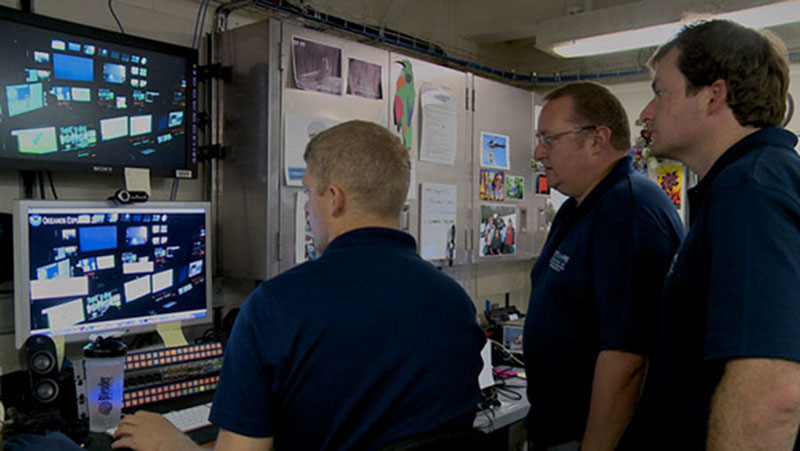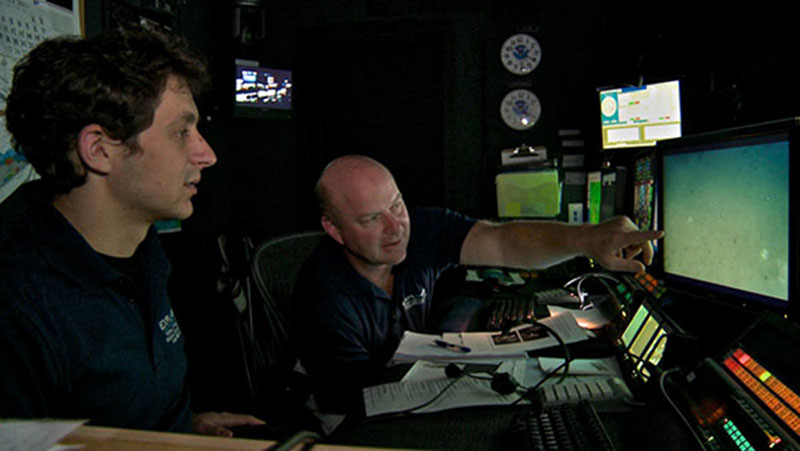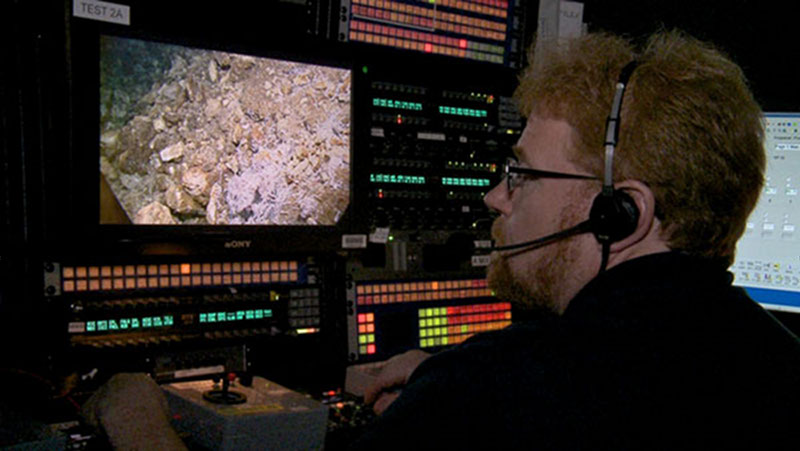
By Webb Pinner, Telepresence Team Lead - NOAA Office of Ocean Exploration and Research
April 17, 2012

Video team lead Webb Pinner showing recently collected video footage to two members of the science party. Image courtesy of the NOAA Office of Ocean Exploration and Research, Gulf of Mexico Expedition 2012. Download larger version (jpg, 1.0 MB).
As with most of the systems aboard the Okeanos Explorer, the video system and the video engineers that operate it play an important role in the ship’s mission of systematic ocean exploration. It is through the video system and engineers that the high-resolution video and still images are captured and quickly relayed to scientists and public audiences around the world.

Video engineer Gregg Diffendale working with a member of the science team to create video clips. Image courtesy of the NOAA Office of Ocean Exploration and Research, Gulf of Mexico Expedition 2012. Download larger version (jpg, 1.0 MB).
The video system has three major components: video streaming, video capture, and video routing.
The video streaming system takes the video from the ship’s cameras and the cameras on the underwater vehicles and converts the video into a format that can be transmitted to shore by satellite and then sent out over the Internet. The entire process takes about 2.5 seconds.
The video capture component is based around an instant-replay system, like those used during the Super Bowl and the Olympics. The system records in a loop; that is when the recorders reach the end of their storage, the recording process starts again at the beginning. This happens 24-hours a day and allows the video engineers to view and save video captured up to four hours in the past. The ability to “go back in time” ensures that the ship never misses a discovery, even if no one saw it coming until it had already passed.
The video routing system is what ties the whole system together. All of the cameras (all 30 of them), monitors (over 20), the instant-replay system, the video streaming system, the video editing suite, and a host of other video-related components are connected to the ship’s video router. The router allows the video engineers to send any camera anywhere or everywhere with just the push of a button.

Video engineer Brian Brinckman adjusts the images from the HD camera on the remotely operated vehicle, Little Hercules. Image courtesy of the NOAA Office of Ocean Exploration and Research, Gulf of Mexico Expedition 2012. Download larger version (jpg, 1.0 MB).
The video engineers are a part of the remotely operated vehicle (ROV) team. Each day the video engineers work side-by-side with the ROV engineers, checking different systems on the ROV before it goes in the water. During the dive it is up to the video engineers to adjust zoom, focus, and color levels on the vehicles high-definition cameras. This is extremely important for maintaining the quality of the video seen by the ROV pilots, scientists, and the public watching over the Internet. Other video engineers are working directly with scientists, making sure to capture enough video to document a discovery.
After an ROV dive is complete the video engineers move to the dry lab. Here they look through all the video and select individual video frames to be used as still images by the scientists and posted in news articles and on websites, including the Ocean Explorer website.
Despite the vast data storage on the Okeanos (13,000 GB) not all the video can be saved. It is up to the video engineers working with scientists that must decide what to keep. The engineers and scientists work together to capture enough video to characterize a site and document discoveries, but also leave plenty of space for the next discovery that could be just minutes away.
The criteria for saving video is not an exact science. The engineers have rough guidelines for what to save based on aesthetic quality, but there are circumstances where this isn’t enough. The other technique used to save clips is actually based on listening to the audio. Scientists get excited when they see something important and when they get excited they get chatty. The video engineers monitor the audio traffic in the control room and save additional clips based on the amount, the traffic, and the general level of excitement in the scientists’ voices.
Although rarely seen by the scientists and public audiences, the video system and the video engineers aboard the Okeanos Explorer play an important role in the ship’s mission. Without the people and the complex array of equipment, the Okeanos Explorer would be unable to show the terrestrial world a view from below.